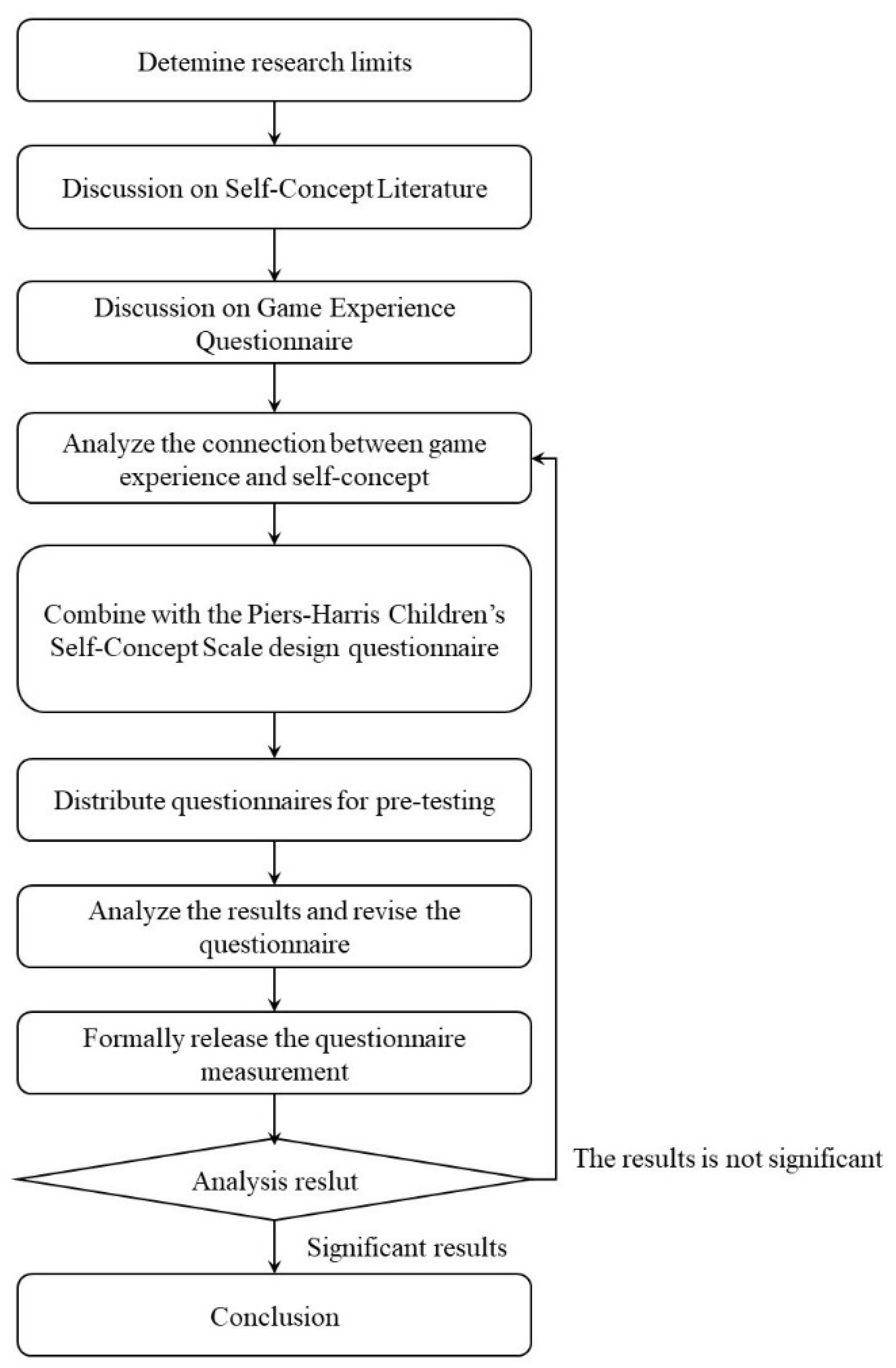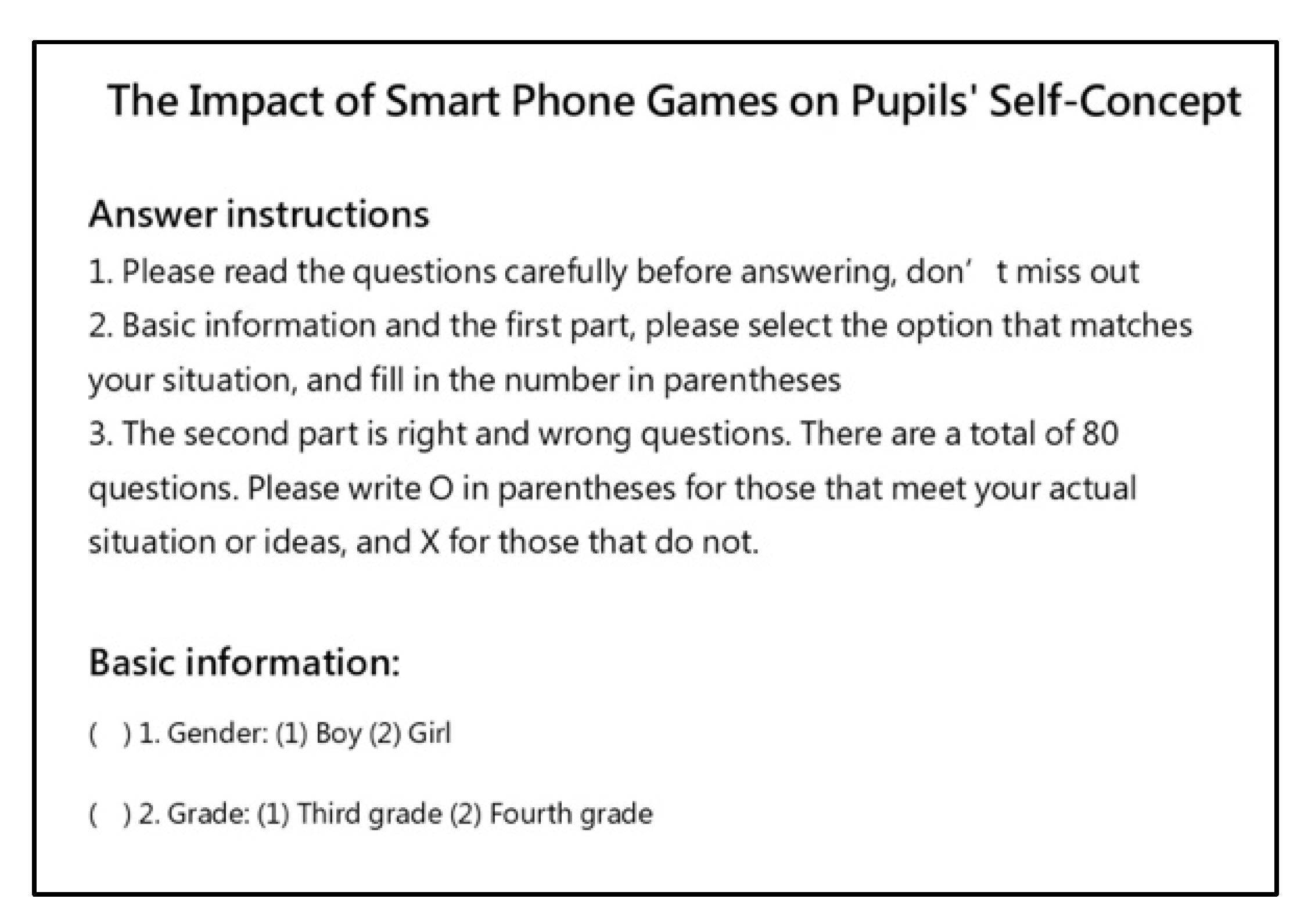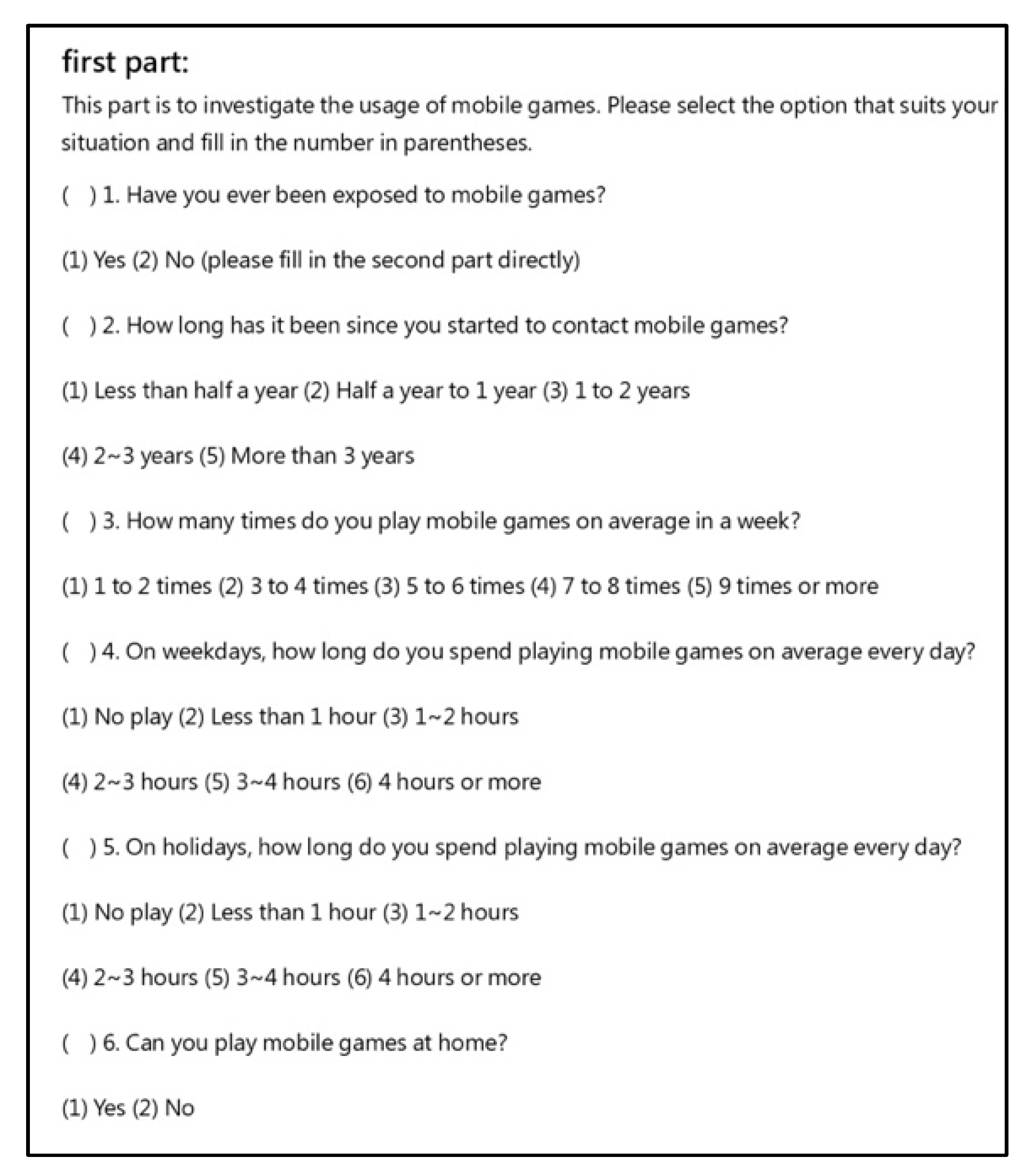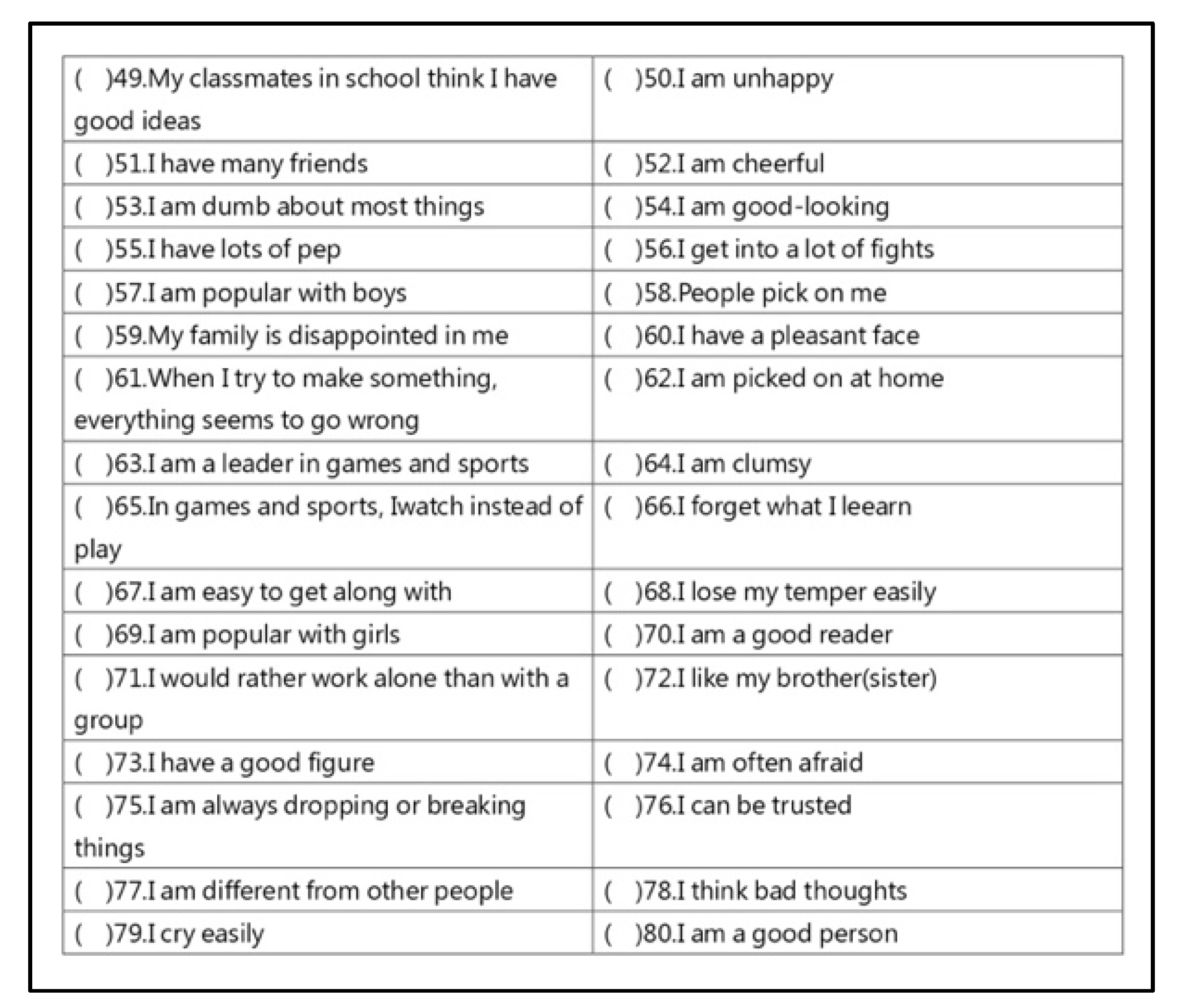In order to complete research objective two (understand the current situation and differences of the self-concept of elementary school students) and research objective three (understand the elementary school students), this section is divided into two parts. The first part is the analysis of the current situation of the self-concept of middle-grade students in elementary school, the second part is the difference in the self-concept of different background variables, and the third part is a comprehensive discussion.
4.2.2. Analysis of Differences in the Self-Concept of Variables in Different Backgrounds
The self-concept subscale and the total score are analyzed and compared with different background variables. In the section, ‘the influence of gender and grade on self-concept’, an independent sample T test is used for analysis and discussion. The influence of concepts part uses single-factor variance analysis for analysis and discussion. The results are as follows:
To check whether the performance of middle-grade students in elementary school is different due to gender differences, an independent sample T test is used for analysis. The results are shown in
Table 5 and
Table 6.
In terms of self-concept, middle-grade elementary school children of different genders show significant differences in the two subscales of Freedom from Anxiety and Popularity.
In terms of Freedom from Anxiety, significance (p = 0.029) <0.05, t = 1.076, indicating a significant difference; the boys’ average (9.04) is higher than the girls’ average (8.67).
In terms of Popularity, significance (p = 0.033) <0.05, t = −4.62, indicating a significant difference. The girls’ average (8.99) is higher than the boys’ average (8.87).
In addition, there were no significant differences in Behavioral Adaptation, Intellectual and School Status, Physical Appearance and Attributes, Happiness and Satisfaction, and Total Score.
There are two significant differences in the self-concept subscale, which means that there is a significant difference in the self-concept, and this difference is shown in Freedom from Anxiety and Popularity. From this, we know that Hypothesis 1 is supported: different genders show significant differences in the self-concept of middle-grade pupils in elementary school.
- (2)
Grade
To check whether the performance of middle-grade students in elementary school is different due to differences in grades, an independent sample T test is used for analysis. The results are shown in
Table 7 and
Table 8.
In terms of self-concept, middle school students of different grades only show significant differences in the Intellectual and School Status subscale.
In terms of Intellectual and School Status, significance (p = 0.016) <0.05, t = 0.199, indicating a significant difference; the average (10.68) of the third grade is higher than the average (1.058) of the fourth grade.
In addition, there are no significant differences in Behavioral Adjustment, Physical Appearance and Attributes, Freedom from Anxiety, Popularity, Happiness and Satisfaction, and Total Score.
There is a significant difference in the self-concept subscale, which means that there is a significant difference in the self-concept, and this difference is shown for Intellectual and School Status. From this, we know that Hypothesis 2 is supported: different grades show significant differences in the self-concept of middle-grade elementary school children.
- (3)
Gaming Experience
To check whether the performance of middle-grade students in elementary school is different due to differences in gaming experience, this part uses one-way ANOVA to analyze. The following is an analysis of the five different questions individually.
Results analyzing if middle-grade students in elementary school have different self-concept performances due to the differences in player qualifications. The average of middle-grade students in elementary school with different player qualifications at the Behavioral Adjustment level is half a year~1 year as the highest: the average is 13.20, and significance is 0.839; Intellectual and School Status level average is highest at 2~3 years: the average is 11.17, and significance is 0.399; the Physical Appearance and Attributes level average has less than half a year as the highest: the average is 8.31, and significance is 0.287; the average of the Freedom from Anxiety level is half a year~1 year: the average is 9.28, and significance is 0.822; the average of the Popularity level is half a year~1 year is the highest: the average is 9.31, and significance is 0.322; Happiness and Satisfaction is less than half a year as the highest: the average is 7.61, and significance is 0.810; Total Score is the overall average—less than half a year is the highest: the average is 56.52, and significance is 0.556. To sum up, in the self-concept of different player qualifications, the significance of all the seven parts is greater than 0.05, and none of them reach a significant difference. Therefore, there is no significant difference in self-concept among middle-grade students in elementary school with different player qualifications.
Results analyzing if middle-grade students in elementary school have different self-concept performances due to differences in play days per week: from the perspective of self-concept, the average of 7 days is the highest in the Behavioral Adjustment level of elementary school children in different play days per week: the average is 12.88, and significance is 0.980; at the Intellectual and School Status level, the average is the highest at 7 days, and it is 10.88, with significance of 0.972; at the Physical Appearance and Attributes level, the average is at 7 days, with an average of 8.11 and a significance of 0.395; at the Freedom from Anxiety level, the average of 3~4 days is the highest, with an average of 9.11, and significance of 0.751; at the Popularity level, the average is the highest at 7 days, and is 9.35, with a significance of 0.482; the highest average at the Happiness and Satisfaction level is at 5~6 days, with an average of 7.64 and significance of 0.813; Total Score overall average is the highest at 7 days, with an average of 55.23 and significance of 0.943.
To summarize, the significance of the seven parts in distinct play days per week in the self-concept is all greater than 0.05, and none of them reach a significant difference. Therefore, there are no significant differences in self-concept among middle-grade students in elementary school of different play days per week.
Results analyzing if middle grade students in elementary school have different self-concept performance due to differences in weekday play times: from the perspective of self-concept, the average value of middle school children in different weekday play times at the Behavioral Adjustment level is 4 h or more; the average is 13.66, and significance is 0.968; at the level of Intellectual and School Status, the average is the highest at less than 1 h: the average is 10.87, and significance is 0.911; at the level of Physical Appearance and Attributes, the highest average is 2~3 h: the average is 8.62, and significance is 0.839; for the Freedom from Anxiety level, the highest average is over 4 h: the average is 9.83, and significance is 0.465; for the Popularity level, the highest average is 2 to 3 h: the average is 9.75, and significance is 0.632; for the Happiness and Satisfaction level, the highest average is 2 to 3 h: the average is 7.87, and significance is 0.900; Total Score overall average is highest at 2 to 3 h: the average is 55.25, and significance is 0.996.
To summarize, in the self-concept of different weekday play times, the significance of the seven parts is greater than 0.05, and none of them reach a significant difference. Therefore, there are no significant differences in self-concept among middle-grade students in elementary school at different weekend play times.
Results analyzing if middle grade students in elementary school have different self-concept performances due to differences in weekend play times. The results are shown in
Table 9 and
Table 10.
According to
Table 9 and
Table 10, from the perspective of self-concept, middle-grade students in elementary school at different weekend play times achieved significant results in the four items of Behavioral Adjustment, Intellectual and School Status, Popularity and Total Score.
Although the significance of Behavioral Adjustment is 0.012 < 0.05, reaching a significant difference, after the Scheffe method, a difference between the groups was not found. In terms of Intellectual and School Status, a significant difference of 0.000 < 0.05 was seen. After the Scheffe method, it is found that the score of weekend play times, less than 1 h (12.07), is higher than the score of 1~2 h (9.89) and more than 4 h score (9.03), but there is no significant difference between 1~2 h and more than 4 h. In terms of Popularity, although the significance is 0.020 < 0.05, which is a significant difference, after the Scheffe’s method, a difference between the groups cannot be found. In terms of Total Score, although the significance is 0.003 < 0.05, reaching a significant difference, after Scheffe’s method, a difference between the groups cannot be found. In addition, there are no significant differences in Physical Appearance and Attributes, Freedom from Anxiety, and Happiness and Satisfaction among elementary school middle-grade students at different weekend play times.
To check if the self-concept performance of middle-grade students in elementary school is different due to the difference in “can I play smartphone games at home”, one-way ANOVA was used to analyze. The results are shown in
Table 11 and
Table 12.
According to
Table 11 and
Table 12, in terms of self-concept, middle-grade students in different “can I play smartphone games at home” have significant differences in terms of Popularity. The significance of Popularity is 0.028 < 0.05, indicating a significant difference. The average (9.04) for those who can play smartphone games at home is greater than the average (8.22) for those who cannot play smartphone games at home.
In addition, there are no significant differences in Behavioral Adjustment, Intellectual and School Status, Physical Appearance and Attributes, Freedom from Anxiety, Happiness and Satisfaction, and Total Score.
4.2.3. Comprehensive Discussion
The statistical analysis results of the self-concept of middle-grade students in elementary school with different background variables are summarized in
Table 13.
After sorting out the results of this research, we obtained the differences between Behavioral Adjustment, Intellectual and School Status, Physical Appearance and Attributes, Freedom from Anxiety, Popularity, Happiness and Satisfaction, and Total Score of the self-concept of elementary school middle-grade students with different background variables.
This study shows that there are significant differences between Freedom from Anxiety and Popularity among middle-grade elementary school children of different genders. However, there are no significant differences in Behavioral Adjustment, Intellectual and School Status, Physical Appearance and Attributes, Happiness and Satisfaction, and overall, in the middle grades of elementary school of different genders. Therefore, Hypothesis 1 is supported: different genders show significant differences in the self-concept of middle-grade pupils in elementary school.
Regarding research on the self-concept of different genders, there are different results. In a study on the relationship between online gaming experience, self-concept, and the sense of meaning of life among senior elementary school children in Kaohsiung city, Wu Xinjie mentioned that the reason why the concept is higher in girls than boys is because girls’ physical and mental development takes place earlier than boys, and they also have better communication skills in the face of interpersonal relationships. Therefore, they are significantly higher than boys in terms of the overall self-concept, individual self, and social self [
54]. This has an impact on self-concept at the Popularity level, resulting in higher scores for girls.
In general, girls hit puberty between the ages of 8–13 years and boys between 9–14 years. Due to better quality of life, coupled with environmental changes, girls are reaching puberty about 1 to 2 years earlier than in the past. In terms of height, puberty age is a critical factor. Taking the third and fourth grades of elementary school as an example, girls often begin to develop earlier than boys and gradually mature in thinking, whereas boys develop later and thus have more childlike innocence and are more easily optimistic about many things. As a result, when it comes to Freedom from Anxiety, boys dominate girls.
This research shows that there are significant differences in Intellectual and School Status among middle-grade students in different grades. Therefore, Hypothesis 2 is supported: different grades have differences in the self-concept of middle-grade students in elementary school. Chen Tongling and Zheng Yazhen point out that there are significant differences in the self-concept of students in the upper grades in elementary school, with the fifth grade being higher than the sixth grade [
55,
56]. This study found that there are significant differences in self-concept among middle-grade students in different grades. Third-grade students were found to be higher than fourth-grade students. Compared to former research, the lower grades are found to be higher than the higher grades. The researcher thinks that it is possible to increase the research results of the lower grades and analyze all six grades of the elementary school together. It may be possible to find the stage at which the self-concept score is the highest.
In this research, regarding the relevance of gaming experience and the self-concept, the following is a breakdown of the question items of different gaming experiences, which are described as follows:
This study shows that there are no significant differences in the self-concept levels of middle-grade students in elementary school with different player qualifications. Researchers believe that smartphone games are a common form of leisure and entertainment for school children, and it may be difficult to judge the relevance of the length of contact with self-concept. The results of this research are the same as Wu Xinjie’s research on online games and the self-concept of elementary school students— there is no significant difference [
54].
- (2)
Play days per week
This study shows that there are no significant differences in the self-concept of middle-grade students with regard to different play days per week.
- (3)
Weekday play times
This research shows that there are no significant differences in the self-concept of middle-grade students at different levels of weekday play times. Researchers believe that during school days, except for school hours, most school children’s play time is approximately one hour, so it has little effect on self-concept levels.
- (4)
Weekend play times
This research shows significant differences in the Intellectual and School Status level of middle-grade students with different weekend play times. Researchers believe that it is a common phenomenon to play smartphone games on holidays; however, the time spent on it should not be too long. Lin Zonghong’s research shows that users can switch to a relaxed mood in a short period of time and relieve stress by playing casual mobile phone games [
52]. Due to the high pressure of schoolwork on weekdays, most of the day is anyway spent on schoolwork, and there is not much time to play. However, with a short time spent on mobile games, students are able to de-stress and can properly use their abilities in other aspects of life. Therefore, in terms of Intellectual and School Status, those with less than 1 h play time had higher scores than those with 1~2 h and more than 4 h. This research result and Wu Xinjie’s research result show that those who play online games for no more than 2 h on holidays perform better than those who play online games for more than 4 h, and those who have less time are higher than those who have higher time [
54].
- (5)
Can I play smartphone games at home?
This study shows that “can I play smartphone games at home” had significant differences in the Popularity level of middle-grade students in elementary school. Those who play smartphone games at home had higher scores than those who cannot play smartphone games at home. Researchers believe that because smartphone games have become a common leisure activity for school children, a part of the interaction among students revolves around smartphone games. The ability to play smartphone games at home increases the interaction between schoolchildren and their classmates; it has a positive influence. Therefore, those who “can play smartphone games at home” have higher scores at the Popularity level than those who cannot.
To summarize, this study shows that elementary school children with different smartphone gaming experiences have significant differences in the Intellectual and School Status and Popularity levels. Therefore, Hypothesis 3 is supported: different smartphone gaming experiences show significant differences in the self-concept of middle-grade students in elementary school.












